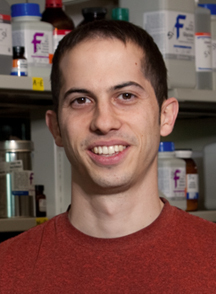TSRI-Designed Drug Candidate Significantly Reduces HIV Reactivation Rate
By Eric Sauter and Mika Ono
HIV-infected patients remain on antiretroviral therapy for life because the virus survives over the long-term in infected dormant cells. Interruption of current types of antiretroviral therapy results in a rebound of the virus and clinical progression to AIDS.
But now, scientists from the Florida campus of The Scripps Research Institute (TSRI) have shown that, unlike other antiretroviral therapies, a natural compound called Cortistatin A reduces residual levels of virus from these infected dormant cells, establishing a near-permanent state of latency and greatly diminishing the virus’ capacity for reactivation.
“Our results highlight an alternative approach to current anti-HIV strategies,” said Susana Valente, a TSRI associate professor who led the study. “Prior treatment with Cortistatin A significantly inhibits and delays viral rebound in the absence of any drug. Our results suggest current antiretroviral regimens could be supplemented with a Tat inhibitor such as Cortistatin A to achieve a functional HIV-1 cure, reducing levels of the virus and preventing reactivation from latent reservoirs.”
The study was published this week in the journal mBio.
Cortistatin A was isolated from a marine sponge, Corticium simplex, in 2006, and in 2008, TSRI chemist Phil Baran won the global race to synthesize the compound. A configuration of the compound, didehydro-Cortistatin A, was shown in earlier studies to target the protein Tat, which exponentially increases viral production.
The new study shows that didehydro-Cortistatin A inhibits replication in HIV-infected cells by significantly reducing levels of viral messenger RNA – the blueprints for producing proteins and more infection.
“In latently infected primary T cells isolated from nine HIV-infected subjects being treated with antiretroviral drugs, didehydro-Cortistatin A reduced viral reactivation by an average of 92.3 percent,” said Research Associate Guillaume Mousseau, the first author of the study and a member of the Valente lab.
The results suggest an alternative to a widely studied strategy for latent HIV eradication known as “kick and kill,” which tries to purge viral reservoirs by “kicking” them out of their latency with reversing agents and stopping new rounds of infection with an immunotherapy agent to boost the body’s own immune system response while on antiretroviral treatment.
“In our proposed model, didehydro-Cortistatin A inhibits the viral transcriptional activator, Tat, far more completely, delaying or even halting viral replication, reactivation and replenishment of the latent viral reservoir,” said Valente.
In addition to Valente and Mousseau, other authors of the study, “The Tat Inhibitor didehydro-Cortistatin A Prevents HIV-1 Reactivation from Latency,” include Cari F. Kessing of TSRI, and Rémi Fromentin, Lydie Trautmann and Nicolas Chomont formerly at the Vaccine and Gene Therapy Institute of Florida. See http://mbio.asm.org/content/6/4/e00465-15.abstract
This work was supported by the National Institutes of Health (grant R01AI097012) and by amfAR, a foundation for AIDS research (fellowship number 108264).
Send comments to: press[at]scripps.edu















